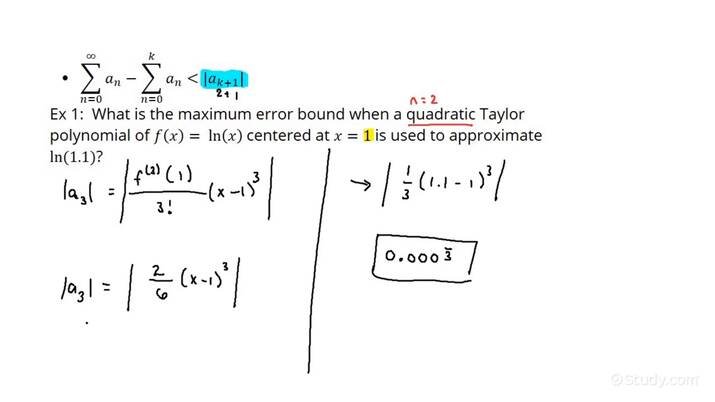Looking to understand the alternating series error bound? In simple terms, the error bound for an alternating series indicates how close the alternating series sum is to its actual value. By learning how to calculate and interpret this bound, you can gain insight into the accuracy of your series approximation. Let’s delve into the fascinating world of alternating series error bounds and unlock the secrets behind their significance. Join me on this journey of discovery to enhance your grasp of series convergence and precision.
The Marvels of Alternating Series Error Bound
Welcome to our exploration of the fascinating world of alternating series error bounds! Have you ever wondered how mathematicians determine the accuracy of series approximations? Well, strap in as we journey through the realm of alternating series, uncovering the secrets of error bounds along the way.
Understanding Alternating Series
Let’s start by understanding what alternating series actually are. An alternating series is a series in which the signs of the terms alternate between positive and negative. For example, an alternating series could look something like this:
$$
1 – \dfrac{1}{2} + \dfrac{1}{3} – \dfrac{1}{4} + \dfrac{1}{5} – \dfrac{1}{6} + \cdots
$$
These series have a unique property that makes them both interesting and challenging to work with. The alternating nature of the terms introduces complexities that traditional series do not possess.
The Need for Error Bounds
When dealing with series approximations, it’s crucial to determine how close our estimate is to the actual value. This is where error bounds come into play. Error bounds provide a range within which the actual value of a series lies.
For alternating series, the error bound is a vital tool in understanding the accuracy of our calculations. It helps us gauge the precision of our approximations and gives us confidence in the validity of our results.
Calculating Error Bounds
Calculating the error bound for an alternating series involves applying specific mathematical techniques that account for the alternating nature of the terms. One common method for determining error bounds is through the Alternating Series Error Bound formula.
The Alternating Series Error Bound formula provides a rigorous way to estimate the error in alternating series approximations. It ensures that we have a clear understanding of how accurate our calculations are and alerts us to any potential discrepancies.
Formula for Alternating Series Error Bound
The formula for the Alternating Series Error Bound is given by:
$$
|R_n| \leq a_{n+1}
$$
Where:
- $$R_n$$ is the remainder when the series is approximated by truncating after the nth term.
- $$a_{n+1}$$ is the absolute value of the subsequent term following the nth term.
This formula serves as a powerful tool for ensuring the accuracy of our alternating series approximations. By calculating the error bound, we can confidently assess the reliability of our results.
Practical Applications
Alternating series error bounds find applications in various fields, including engineering, physics, and finance. These error bounds play a crucial role in ensuring the precision of calculations and are indispensable in complex mathematical analyses.
Engineers rely on error bounds to validate their designs and simulations, knowing that even small errors can have significant consequences. By leveraging alternating series error bounds, engineers can minimize uncertainties and optimize their projects.
In the realm of physics, error bounds are essential for verifying the accuracy of experimental data and theoretical models. Physicists use these bounds to assess the reliability of their calculations and fine-tune their theories to match real-world observations.
Financial analysts also benefit from error bounds when evaluating risks and forecasting trends. By understanding the potential errors in their projections, analysts can make informed decisions that drive successful investments and strategies.
In conclusion, alternating series error bounds are powerful tools that enable us to navigate the complexities of series approximations with confidence. By utilizing error bounds, we can ensure the accuracy of our calculations and make informed decisions based on reliable data.
Whether you’re a budding mathematician, an aspiring engineer, or a curious mind seeking knowledge, the world of alternating series error bounds offers a wealth of insights and opportunities for exploration. Embrace the challenge, dive into the details, and uncover the marvels of error bounds in alternating series!
Calculus BC – 10.10 Alternating Series Error Bound
Frequently Asked Questions
What is the alternating series error bound?
The alternating series error bound provides an estimate of the error when approximating the sum of an alternating series with a partial sum. It helps determine how close the partial sum is to the actual sum of the series.
How is the alternating series error bound calculated?
The alternating series error bound can be calculated using the formula: Error Bound ≤ |a_{n+1}|, where a_{n+1} is the next term in the alternating series after the last term included in the partial sum.
Why is the alternating series error bound important in numerical analysis?
The alternating series error bound is crucial in numerical analysis because it allows us to control and quantify the error introduced by truncating the series after a certain number of terms. This helps ensure the accuracy of calculations and approximations.
Can the alternating series error bound be used to guarantee convergence of a series?
No, the alternating series error bound itself cannot guarantee the convergence of a series. However, it provides valuable information about the accuracy of approximating the sum of an alternating series, which can be useful in analyzing the behavior of the series.
Final Thoughts
In conclusion, the alternating series error bound provides a crucial tool for estimating the error in approximating a series. By leveraging the alternating series test, we can determine how accurate our approximations are. Understanding the concept allows us to confidently assess the reliability of our calculations. Consider the alternating series error bound as a valuable resource in your mathematical toolkit.

